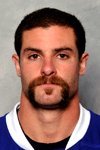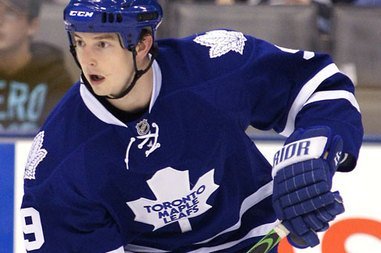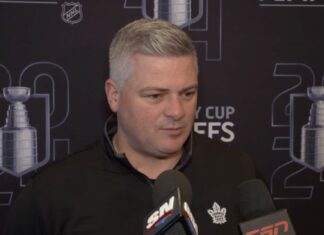
Please read the preceding article in this series on top 6 forwards here. For this article, the bottom 6 forwards on the Leafs are: Colby Armstrong, Joey Crabb, John Mitchell, Darryl Boyce, Fredrik Sjostrom, Tim Brent, Mike Brown, Jay Rosehill and Colton Orr. I decided to leave Kadri out of my forward reviews due to his few games played in conjunction with his rapid change from top 6 to bottom 6 from game to game.
When all is said and done, the bottom 6 forwards on Toronto in the 2010-11 season dropped the ball in a big way. This is no more obvious than in their scoring. We’ve established that Toronto’s top 6 scored at a decent clip, but the bottom 6 had almost none at all. The leading scorer in Toronto’s bottom 6 was Colby Armstrong with a measly 8 goals. Third liners should all be expected to score at least 12-15 goals per year if you want to be a serious championship contender. In 09-10, the leading bottom 6 scorer on the Leafs was Lee Stempniak, who managed 14 goals in 62 games (and somehow ending the year with 28). It goes without saying that if a bottom 6 group scores as little as Toronto’s did this season, they have to be making up for it with some stellar defensive play. Let’s take a look at some of the relatively unseen stats (which can be found at BehindTheNet.ca) and see what we can find.
Here’s how the scoring is broken down among the bottom 6:
| Name | Games Played | Goals | Assists | Points |
| Colby Armstrong | 50 | 8 | 15 | 23 |
| Tim Brent | 79 | 8 | 12 | 20 |
| Joey Crabb | 48 | 3 | 12 | 15 |
| Darryl Boyce | 46 | 5 | 8 | 13 |
| Mike Brown | 50 | 3 | 5 | 8 |
| Fredrik Sjostrom | 66 | 2 | 3 | 5 |
| John Mitchell | 23 | 2 | 1 | 3 |
| Jay Rosehill | 26 | 1 | 2 | 3 |
| Colton Orr | 46 | 2 | 0 | 2 |
*Stats are for even strength
These totals are unacceptable for any team. Some are worse than others. Colby Armstrong played fewer games than most of the others and yet has the highest goal and point totals. Darryl Boyce and Joey Crabb both spent time on the third line, making their totals stand out. The worst totals come from Jay Rosehill and Colton Orr, though this is no surprise considering the kind of players they are. Perhaps the best totals come from Tim Brent, a player that spent nearly the entire season on the fourth line and yet managed 8 goals and 20 points. That is perfect production from a bottom line player.
Next, let`s take a look at some Corsi stats:
| Name | Corsi ON | Corsi OFF | Corsi REL |
| Colby Armstrong | -3.61 | -5.74 | 2.1 |
| Darryle Boyce | -15.20 | -8.36 | -6.8 |
| John Mitchell | -6.05 | 0.92 | -7.0 |
| Joey Crabb | -15.16 | -7.47 | -7.7 |
| Fredrik Sjostrom | -13.85 | -2.58 | -11.3 |
| Mike Brown | -20.19 | -4.04 | -16.2 |
| Tim Brent | -18.63 | -2.07 | -16.6 |
| Jay Rosehill | -24.45 | -4.24 | -20.2 |
| Colton Orr | -21.05 | 1.01 | -22.1 |
*Stats are for even strength
Corsi is a stat that measures offensive opportunities given and received, tracked through attempted shots. To put it simply, any time a player’s team attempts a shot at the opponents’ net (whether it be shots on goal, missed shots or blocked shots), their Corsi rating goes up. Similarly, a player’s Corsi goes down if they suffer an attempt on their own net by their opponents. Corsi ON tracks a player’s Corsi ranking when they’re on the ice, while Corsi OFF tracks that player’s team when the player is on the bench. Corsi REL is then the most important stat, as it subtracts Corsi OFF from Corsi ON in an attempt to find that player’s true Corsi relative to his teammates. So for Colby Armstrong, even though his Corsi ON is negative, his Corsi REL is positive due to his being on a bad team. That only one player in the bottom 6 has a positive Corsi is a major part of the problem. Again, there is no surprise to see that Jay Rosehill and Colton Orr bottom out this category as well. What is interesting about this pile of stats is that John Mitchell and Colton Orr both have a positive Corsi OFF. This means that Toronto actually had more offensive chances than their opponents when those two players were not on the ice.
Corsi is a particularly damning stat for bottom 6 forwards. There is a certain expectation among these types of players to not only be defensively sound, but also to create energy and rush the puck to the other end of the ice. What we instead see on the Maple Leafs are a bunch of players that provide little offense and still manage to suffer from defensive lapses.
Now let’s finish up with a few more stats:
| Name | Ozone% | Fin Ozone% | QUALCOMP | Blocked Shots | Hits |
| J. Mitchell | 57.5 | 53.0 | -0.049 | 17 | 31 |
| J. Rosehill | 50.0 | 47.1 | -0.110 | 4 | 36 |
| C. Armstrong | 46.1 | 50.9 | -0.026 | 28 | 88 |
| C. Orr | 45.4 | 40.9 | -0.110 | 9 | 46 |
| F. Sjostrom | 45.0 | 47.3 | 0.017 | 33 | 108 |
| D. Boyce | 44.1 | 51.6 | 0.024 | 19 | 68 |
| M. Brown | 43.0 | 48.4 | -0.070 | 27 | 105 |
| J. Crabb | 42.9 | 46.1 | 0.004 | 20 | 99 |
| T. Brent | 41.1 | 45.9 | -0.030 | 58 | 104 |
*Blocked shots and hits encompass all ES, PK and PP time
Ozone% looks at the frequency at which a player starts their shift in the offensive zone, tracked in percent, while Fin Ozone% looks at the frequency at which that player ends their shift in the offensive zone. John Mitchell is the runaway winner for Ozone%, suggesting the coaching staff had about as much faith in his defensive abilities as Leafs fans. Most of them are below 50%, but this is hardly strange for bottom 6 players. Most have a positive start to finish ratio, with Armstrong, Boyce, Brown and Brent being particularly impressive.
As for QUALCOMP, it measures a player’s relation to their opponents. It stands for “Quality of Competition”, with positive numbers suggesting stronger opponents and negative numbers suggesting worse opponents. Of this group, Darryl Boyce faced the most consistently tough opponents while Colton Orr and Jay Rosehill unsurprisingly faced the easiest opponents. Blocked shots were a bit of a rough category for this year’s bottom 6, but Tim Brent’s high PK time allowed him to come away the winner with 58. Hits were another sore spot, with more than a few players who didn’t hit nearly enough.
Very few players come away with a passing grade in this year’s bottom 6. Of the players examined, I would say that only Armstrong, Brown and Brent were effective on the ice. Darryl Boyce definitely brought a lot of heart, but I’m not sure he has the skills to keep up at the top level. As for Rosehill and Orr, they seem to be two of the last of a dying breed. The traditional goon seems to be slowly abandoned in this much faster post-lockout NHL. Goons are now built in the mould of Colby Armstrong; a player that can be tough while contributing to his team. I doubt Brian Burke shares my sentiment, however. The Leafs need a far better bottom 6 next year to compete for a playoff spot. If they target players like Maxime Talbot, Mike Rupp and Scottie Upshall tomorrow, this team could be greatly improved.




![Sheldon Keefe Post Game, Leafs 3 vs. Bruins 2: “I loved [the Matthews] line, and I loved a lot about our game all the way through the lineup” Sheldon Keefe, Toronto Maple Leafs post game](https://mapleleafshotstove.com/wp-content/uploads/2024/04/keefe-pg-game-1-218x150.jpg)


























![Sheldon Keefe Post Game, Leafs 3 vs. Bruins 2: “I loved [the Matthews] line, and I loved a lot about our game all the way through the lineup” Sheldon Keefe, Toronto Maple Leafs post game](https://mapleleafshotstove.com/wp-content/uploads/2024/04/keefe-pg-game-1-100x70.jpg)



